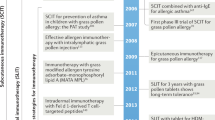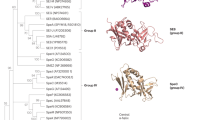Abstract
EAE can refer either to experimental autoimmune encephalomyelitis or experimental allergic encephalomyelitis. Although EAE is classically a prototypic T helper 1 (TH1) cell–mediated autoimmune disease, it can also be induced by TH2 cells. Characteristically, the most severe manifestation of allergy, anaphylaxis, is associated with exposure to a foreign antigen that is often derived from medication, insect venom or food. We report here that, after self-tolerance to myelin is destroyed, anaphylaxis may be triggered by a self-antigen, in this case a myelin peptide. “Horror autotoxicus”, which was initially described by Ehrlich, may not only include autoimmunity to self, it may also encompass immediate hypersensitivity to self, which leads to shock and rapid death.
This is a preview of subscription content, access via your institution
Access options
Subscribe to this journal
Receive 12 print issues and online access
$209.00 per year
only $17.42 per issue
Buy this article
- Purchase on Springer Link
- Instant access to full article PDF
Prices may be subject to local taxes which are calculated during checkout






Similar content being viewed by others
References
Vandenbark, A. A. et al. Specificity of T lymphocyte lines for peptides of myelin basic protein. J. Immunol. 135, 229–233 (1985).
Brosnan, C. F., Selmaj, K. & Raine, C. S. Hypothesis: a role for tumor necrosis factor in immune-mediated demyelination and its relevance to multiple sclerosis. J. Neuroimmunol. 18, 87–94 (1988).
Abbas, A. K., Murphy, K. M. & Sher, A. Functional diversity of helper T lymphocytes. Nature 383, 787–793 (1996).
Bochner, B. S. & Lichtenstein, L. M. Anaphylaxis. N. Engl. J. Med. 324, 1785–1790 (1991).
Galli, S. J. & Lantz, C. S. in Fundamental Immunology (ed. Paul, W. E.) 1137–1184 (Lippincott-Raven Press, Philadelphia, 1999).
Ishizaka, T. & Ishizaka, K. Activation of mast cells for mediator release through IgE receptors. Prog. Allergy 34, 188–235 (1984).
Mota, I. & Wong, D. Homologous and heterologous passive cutaneous anaphylactic activity of mouse antisera during the course of immunization. Life Sci. 8, 813–820 (1969).
Miyajima, I. et al. Systemic anaphylaxis in the mouse can be mediated largely through IgG1 and FcγRIII. Assessment of the cardiopulmonary changes, mast cell degranulation, and death associated with active or IgE- or IgG1-dependent passive anaphylaxis. J. Clin. Invest. 99, 901–914 (1997).
Liblau, R. S., Singer, S. M. & McDevitt, H. O. Th1 and Th2 CD4+ T cells in the pathogenesis of organ-specific autoimmune diseases. Immunol. Today 16, 34–38 (1995).
Lafaille, J. J. et al. Myelin basic protein-specific T helper 2 (Th2) cells cause experimental autoimmune encephalomyelitis in immunodeficient hosts rather than protect them from the disease. J. Exp. Med. 186, 307–312 (1997).
Linthicum, D. S. Development of acute autoimmune encephalomyelitis in mice: factors regulating the effector phase of the disease. Immunobiology 162, 211–220 (1982).
Dietsch, G. N. & Hinrichs, D. J. The role of mast cells in the elicitation of experimental allergic encephalomyelitis. J. Immunol. 142, 1476–1481 (1989).
Bebo, B. F. Jr, Lee, C. H., Orr, E. L. & Linthicum, D. S. Mast cell-derived histamine and tumour necrosis factor: differences between SJL/J and BALB/c inbred strains of mice. Immunol. Cell. Biol. 74, 225–230 (1996).
Brenner, T., Soffer, D., Shalit, M. & Levi-Schaffer, F. Mast cells in experimental allergic encephalomyelitis: characterization, distribution in the CNS and in vitro activation by myelin basic protein and neuropeptides. J. Neurol. Sci. 122, 210–213 (1994).
Toms, R., Weiner, H. L. & Johnson, D. Identification of IgE-positive cells and mast cells in frozen sections of multiple sclerosis brains. J. Neuroimmunol. 30, 169–177 (1990).
Olsson, Y. Mast cells in plaques of multiple sclerosis. Acta Neurol. Scand. 50, 611–618 (1974).
Kruger, P. G. et al. Mast cells and multiple sclerosis: a light and electron microscopic study of mast cells in multiple sclerosis emphasizing staining procedures. Acta Neurol. Scand. 81, 31–36 (1990).
Linthicum, D. S. & Frelinger, J. A. Acute autoimmune encephalomyelitis in mice. II. Susceptibility is controlled by the combination of H-2 and histamine sensitization genes. J. Exp. Med. 156, 31–40 (1982).
Johnson, D., Seeldrayers, P. A. & Weiner, H. L. The role of mast cells in demyelination. 1. Myelin proteins are degraded by mast cell proteases and myelin basic protein and P2 can stimulate mast cell degranulation. Brain Res. 444, 195–198 (1988).
Dines, K. C. & Powell, H. C. Mast cell interactions with the nervous system: relationship to mechanisms of disease. J. Neuropathol. Exp. Neurol. 56, 627–640 (1997).
Secor, V. H., Secor, W. E., Gutekunst, C. A. & Brown, M. A. Mast cells are essential for early onset and severe disease in a murine model of multiple sclerosis. J. Exp. Med. 191, 813–822 (2000).
Linthicum, D. S., Munoz, J. J. & Blaskett, A. Acute experimental autoimmune encephalomyelitis in mice. I. Adjuvant action of Bordetella pertussis is due to vasoactive amine sensitization and increased vascular permeability of the central nervous system. Cell. Immunol. 73, 299–310 (1982).
Soloway, P. et al. Regulation of the immune response to peptide antigens: differential induction of immediate-type hypersensitivity and T cell proliferation due to changes in either peptide structure or major histocompatibility complex haplotype. J. Exp. Med. 174, 847–858 (1991).
Dombrowicz, D. et al. Absence of FcɛRI α chain results in upregulation of FcγRIII-dependent mast cell degranulation and anaphylaxis. Evidence of competition between FcɛRI and FcγRIII for limiting amounts of FcR β and γ chains. J. Clin. Invest. 99, 915–925 (1997).
Kuchroo, V. K. et al. A single TCR antagonist peptide inhibits experimental allergic encephalomyelitis mediated by a diverse T cell repertoire. J. Immunol. 153, 3326–3336 (1994).
Hurtenbach, U., Lier, E., Adorini, L. & Nagy, Z. A. Prevention of autoimmune diabetes in non-obese diabetic mice by treatment with a class II major histocompatibility complex-blocking peptide. J. Exp. Med. 177, 1499–1504 (1993).
Tuohy, V. K., Lu, Z., Sobel, R. A., Laursen, R. A. & Lees, M. B. Identification of an encephalitogenic determinant of myelin proteolipid protein for SJL mice. J. Immunol. 142, 1523–1527 (1989).
Anderson, A. C. et al. High frequency of autoreactive myelin proteolipid protein-specific T cells in the periphery of naive mice: mechanisms of selection of the self-reactive repertoire. J. Exp. Med. 191, 761–770 (2000).
Encinas, J. A., Weiner, H. L. & Kuchroo, V. K. Inheritance of susceptibility to experimental autoimmune encephalomyelitis. J. Neurosci. Res. 45, 655–669 (1996).
Steinman, L. et al. Murine model for pertussis vaccine encephalopathy: linkage to H-2. Nature. 299, 738–740 (1982).
Pribyl, T. M. et al. The human myelin basic protein gene is included within a 179-kilobase transcription unit: expression in the immune and central nervous systems. Proc. Natl Acad. Sci. USA 90, 10695–10699 (1993).
Zelenika, D., Grima, B. & Pessac, B. A new family of transcripts of the myelin basic protein gene: expression in brain and in immune system. J. Neurochem. 60, 1574–1577 (1993).
Radu, C. G., Anderton, S. M., Firan, M., Wraith, D. C. & Ward, E. S. Detection of autoreactive T cells in H-2(u) mice using peptide-MHC multimers. Int. Immunol. 12, 1553–1560 (2000).
Liu, G. Y. et al. Low avidity recognition of self-antigen by T cells permits escape from central tolerance. Immunity. 3, 407–415 (1995).
Zamvil, S. et al. T-cell clones specific for myelin basic protein induce chronic relapsing paralysis and demyelination. Nature 317, 355–358 (1985).
Zamvil, S. S. et al. T-cell epitope of the autoantigen myelin basic protein that induces encephalomyelitis. Nature 324, 258–260 (1986).
Jensen, M. A., Dayal, A. & Arnason, B. G. Cytokine secretion by δγ and αβ T cells in monophasic experimental autoimmune encephalomyelitis. J. Autoimmun. 12, 73–80 (1999).
Begolka, W. S., Vanderlugt, C. L., Rahbe, S. M. & Miller, S. D. Differential expression of inflammatory cytokines parallels progression of central nervous system pathology in two clinically distinct models of multiple sclerosis. J. Immunol. 161, 4437–4446 (1998).
Faquim-Mauro, E. L., Coffman, R. L., Abrahamsohn, I. A. & Macedo, M. S. Cutting edge: mouse IgG1 antibodies comprise two functionally distinct types that are differentially regulated by IL-4 and IL-12. J. Immunol. 163, 3572–3576 (1999).
Kim, R. Anaphylaxis to protamine masquerading as an insulin allergy. Del. Med. J. 65, 17–23 (1993).
Schernthaner, G. Immunogenicity and allergenic potential of animal and human insulins. Diabetes Care 16, 155–165 (1993).
Bove, J. R. & McIntosh, S. Anaphylactic reaction to purified anti-hemophilic factor concentrate. Transfusion 28, 603 (1988).
Shopnick, R. I. et al. Anaphylaxis after treatment with recombinant factor VIII. Transfusion 36, 358–361 (1996).
Davis, H. M. et al. Lack of immune response to mouse IgG in hemophilia A patients treated chronically with Monoclate, a monoclonal antibody affinity purified factor VIII preparation. Thromb. Haemost. 63, 386–391 (1990).
Oro, A. S., Guarino, T. J., Driver, R., Steinman, L. & Umetsu, D. T. Regulation of disease susceptibility: decreased prevalence of IgE- mediated allergic disease in patients with multiple sclerosis. J. Allergy Clin. Immunol. 97, 1402–1408 (1996).
Kappos, L. et al. Induction of a non-encephalitogenic type 2 T helper-cell autoimmune response in multiple sclerosis after administration of an altered peptide ligand in a placebo-controlled, randomized phase II trial. Nature Med. 6, 1176–1182 (2000).
Genain, C. P. et al. Late complications of immune deviation therapy in a nonhuman primate. Science 274, 2054–2057 (1996).
Klein, L., Klugmann, M., Nave, K. A. & Kyewski, B. Shaping of the autoreactive T-cell repertoire by a splice variant of self protein expressed in thymic epithelial cells. Nature Med. 6, 56–61 (2000).
Steinman, L. Multiple approaches to multiple sclerosis. Nature Med. 6, 15–16 (2000).
Schwartz, M. & Cohen, I. R. Autoimmunity can benefit self-maintenance. Immunol. Today 21, 265–268 (2000).
Ruiz, P. J. et al. Suppressive immunization with DNA encoding a self-peptide prevents autoimmune disease: modulation of T cell costimulation. J. Immunol. 162, 3336–3341 (1999).
Waisman, A. et al. Suppressive vaccination with DNA encoding a variable region gene of the T-cell receptor prevents autoimmune encephalomyelitis and activates Th2 immunity. Nature Med. 2, 899–905 (1996).
Spergel, J. M. et al. Epicutaneous sensitization with protein antigen induces localized allergic dermatitis and hyperresponsiveness to methacholine after single exposure to aerosolized antigen in mice. J. Clin. Invest. 101, 1614–1622 (1998).
Wershil, B. K., Murakami, T. & Galli, S. J. Mast cell-dependent amplification of an immunologically nonspecific inflammatory response. Mast cells are required for the full expression of cutaneous acute inflammation induced by phorbol 12-myristate 13- acetate. J. Immunol. 140, 2356–2360 (1988).
Williams, C. M. & Galli, S. J. Mast cells can amplify airway reactivity and features of chronic inflammation in an asthma model in mice. J. Exp. Med. 192, 455–462 (2000).
Acknowledgements
We thank Z-S. Wang for technical assistance and H. McDevitt, T. Staehelin, A. Pedotti, P. Decamilli, P. Ghezzi and L. Stark for critical reading of the manuscript. Supported (in part) by a postdoctoral fellowship from the National Multiple Sclerosis Society (to R. P.) and support from the National Institutes of Health and the Phil N. Allen Fund.
Author information
Authors and Affiliations
Corresponding author
Rights and permissions
About this article
Cite this article
Pedotti, R., Mitchell, D., Wedemeyer, J. et al. An unexpected version of horror autotoxicus: anaphylactic shock to a self-peptide. Nat Immunol 2, 216–222 (2001). https://doi.org/10.1038/85266
Received:
Accepted:
Issue Date:
DOI: https://doi.org/10.1038/85266
This article is cited by
-
Long-term tolerance of islet allografts in nonhuman primates induced by apoptotic donor leukocytes
Nature Communications (2019)
-
Sequential transcriptional changes dictate safe and effective antigen-specific immunotherapy
Nature Communications (2014)
-
Development of therapies for autoimmune disease at Stanford: a tale of multiple shots and one goal
Immunologic Research (2014)
-
Immunogenicity to Biologics: Mechanisms, Prediction and Reduction
Archivum Immunologiae et Therapiae Experimentalis (2012)
-
T cell recognition of weak ligands: roles of signaling, receptor number, and affinity
Immunologic Research (2011)



